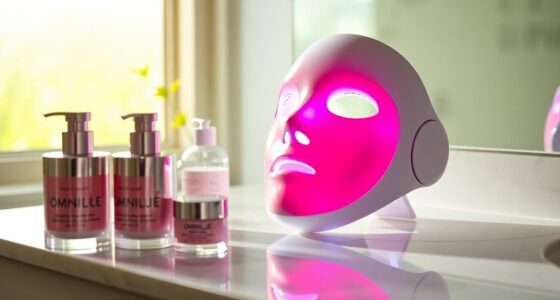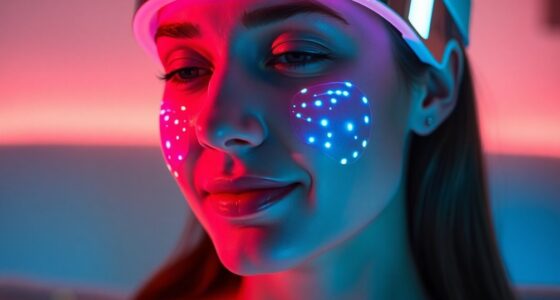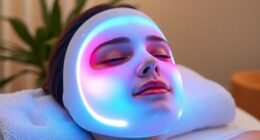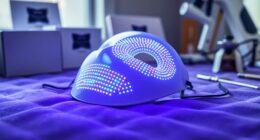LED masks use therapeutic light wavelengths to address various skin concerns. Red light boosts collagen, reducing wrinkles and improving texture, while blue light targets acne-causing bacteria. Near-infrared light enhances blood circulation for faster healing. Regular use can lead to hydrated, firmer skin and visible improvements in tone and texture. Many users report a calming effect on irritated skin. Want to discover more about how to use these masks effectively and the benefits they offer?
Key Takeaways
- LED masks utilize specific light wavelengths to boost collagen production, reduce wrinkles, and improve overall skin texture.
- Blue light targets acne-causing bacteria, helping to reduce breakouts and regulate oil production.
- Red light enhances hydration and reduces inflammation, promoting a firmer, more youthful appearance.
- Near-infrared light improves blood circulation, aiding in faster healing and rejuvenation of the skin.
- Regular use of LED masks can lead to noticeable improvements in skin tone, texture, and hydration levels.
Understanding LED Masks and Their Functionality

When you think about skincare innovations, LED masks stand out for their ability to harness light to enhance your skin’s health.
These masks utilize specific wavelengths of light, particularly red and blue light therapy, to target various skin concerns effectively. Red light therapy, with wavelengths from 630 to 660 nanometers, boosts collagen production, reducing wrinkles and fine lines while improving microcirculation.
Conversely, blue light therapy, at around 405 to 420 nanometers, serves as an acne treatment by eliminating acne-causing bacteria. Many LED masks are FDA cleared, ensuring their safety and efficacy in your skincare routine.
Regular use, typically for 5-20 minutes daily, can lead to significant improvements in skin texture, hydration, and overall appearance, delivering impressive anti-aging benefits.
The Benefits of Using LED Masks on Your Skin

Using LED masks can transform your skincare routine by delivering a range of benefits that enhance your skin’s health and appearance.
These masks stimulate collagen production, helping to reduce fine lines and improve texture. Red light therapy is particularly effective for anti-aging, while blue light targets acne-causing bacteria.
With consistent use, typically 10 to 20 minutes several times a week, you’ll notice cumulative benefits like enhanced hydration and firmness. They also promote better blood circulation, which aids in nutrient delivery and accelerates the healing properties of your skin.
Safe for all skin types, LED masks offer visible improvements in skin conditions without the downtime of invasive treatments, making them a valuable addition to your regimen.
Different Types of Light and Their Effects

When you use LED masks, each type of light offers unique benefits for your skin.
Red light boosts collagen production and improves texture, while blue light targets acne-causing bacteria.
Understanding these differences can help you choose the right treatment for your specific skin needs.
Red Light Benefits
While exploring the benefits of different light therapies, you’ll find that red light therapy stands out for its remarkable ability to enhance skin health.
This therapy boosts collagen production, helping to reduce wrinkles and fine lines while improving overall skin firmness. When you use LED masks featuring red light, you’re promoting increased cell turnover, which aids in cellular repair and rejuvenation.
Additionally, this therapy can help with inflammation, making it beneficial for those with acne-prone skin. By targeting deeper layers of your skin, red light therapy not only enhances your complexion but also works to achieve a more even skin tone.
Embracing this powerful light can lead to healthier, more youthful-looking skin.
Blue Light Effects
After exploring the benefits of red light therapy, it’s time to contemplate blue light therapy and its particular advantages for skin health.
Here are some key effects of blue light therapy:
- Targets acne-causing bacteria effectively.
- Possesses anti-inflammatory properties, reducing redness.
- Regulates oil production, helping prevent flare-ups.
- Safe for various skin types and often combined with red light for enhanced skin benefits.
Blue light therapy operates within the wavelength range of 405 to 420 nanometers, proving particularly effective for mild to moderate acne.
Regular use can lead to significant improvements in skin clarity and overall health.
It’s a popular choice in dermatological treatments, making it a valuable addition to your skincare routine.
Other Light Wavelengths
Light therapy encompasses various wavelengths, each offering unique benefits for your skin.
Red light, with wavelengths from 630 to 660 nanometers, boosts collagen production, improves microcirculation, and reduces inflammation, making it ideal for anti-aging treatments.
Near-infrared light penetrates deeper layers of skin, enhancing cell turnover and collagen production.
If acne‘s your concern, blue light targets bacteria, regulating oil production and reducing breakouts.
Yellow light stimulates red blood cell production, improving circulation and brightening your complexion.
Finally, green light therapy works wonders for uneven skin tone by reducing pigmentation and diminishing dark spots.
Incorporating these different wavelengths through LED light therapy can notably enhance your skin care routine and help you achieve healthier, more radiant skin.
How to Use LED Masks for Optimal Results
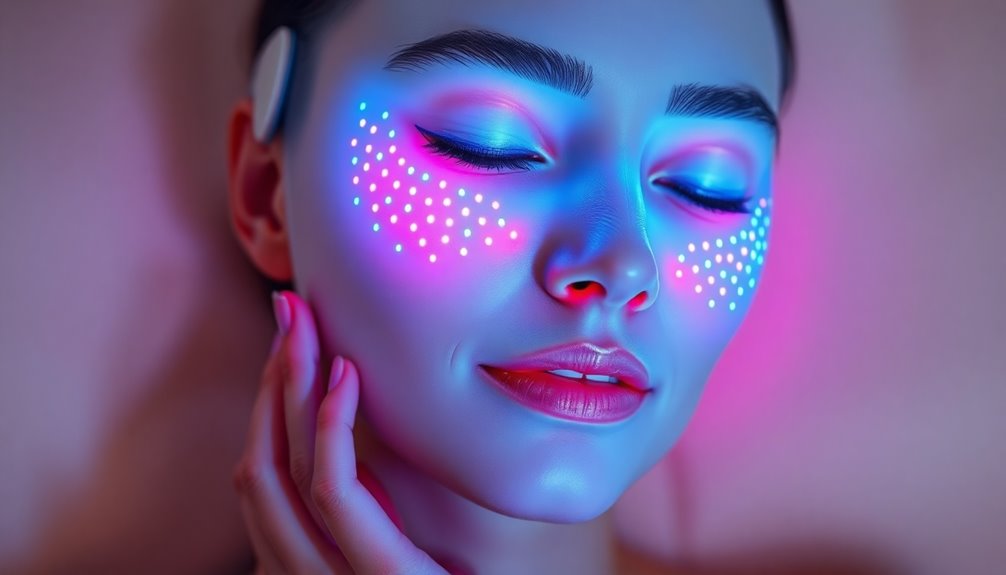
To get the best results from your LED mask, start by making sure your face is clean and dry.
Stick to the recommended session times and frequency—aim for 3 to 5 times a week for ideal benefits.
After each session, don’t forget to apply hydrating skincare products for enhanced recovery.
Preparation and Application Steps
Using an LED mask effectively starts with proper preparation. To maximize your results, follow these steps:
- Cleanse your face thoroughly and let it dry to enhance light penetration.
- Adhere to session times recommended by the manufacturer, usually between 3 to 10 minutes per treatment.
- Apply hydrating skincare products post-treatment to lock in moisture and amplify the benefits of the LED therapy.
- Document your progress with before-and-after photos to track visible improvements.
Consistency is essential; aim for 3 to 5 sessions a week for at least a month.
This approach will help you see noticeable improvements in your skin’s texture and tone, making your LED mask experience truly rewarding.
Frequency and Duration Guidelines
Achieving ideal results with your LED mask hinges on understanding the right frequency and duration for your sessions. For optimal improvements in skin texture and hydration, aim to use your LED mask 3 to 5 times a week.
Each session should last between 3 to 20 minutes, depending on your specific device’s guidelines. After each session, applying hydration-focused skincare products can enhance the benefits you’ve gained.
It’s also essential to avoid using LED masks alongside retinoids, as this can lead to skin irritation. To track your progress, take photos over at least one month, allowing you to assess the effectiveness of your treatment.
Stick to these frequency and duration guidelines for the best results!
Safety Considerations and Potential Risks

While LED masks are generally safe for most users, it’s crucial to contemplate specific safety measures and potential risks before starting treatment.
Here are some key safety considerations to keep in mind:
- Light Sensitivity: If you’re sensitive to light, consult a dermatologist before use.
- Eye Protection: Always wear appropriate eye protection, especially with blue light, to prevent damage from prolonged exposure.
- Session Durations: Stick to recommended session durations of 3 to 10 minutes to minimize irritation and adverse reactions.
- FDA Approved: Verify that the LED mask you’re using is FDA approved, as not all models have undergone rigorous safety testing.
Personal Experience and Results With LED Masks
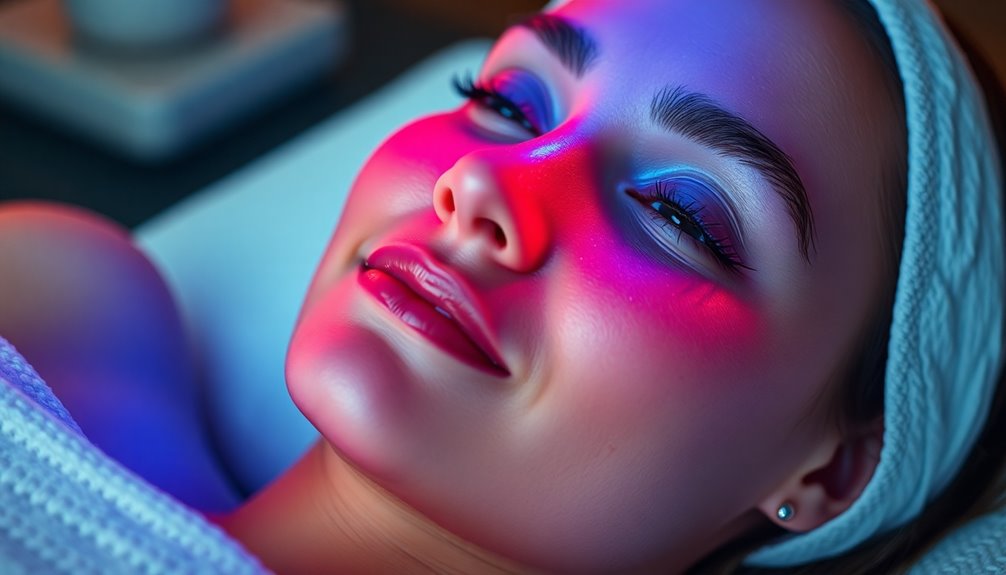
After considering safety measures, you might be enthusiastic to explore how LED masks actually work in practice. Many users, including yourself, have experienced remarkable results from regular use.
With consistent sessions of red light therapy, you can improve skin texture and reduce fine lines by boosting collagen production. If acne is a concern, blue light therapy effectively targets bacteria, decreasing breakouts.
Users have noted enhanced hydration and firmness after daily 5-20 minute sessions over two months. Additionally, LED masks with near-infrared light improve blood circulation, aiding in nutrient delivery and faster healing.
Personal experiences reveal relief from skin issues like redness and tightness, especially after travel or environmental stressors. You’ll likely find these benefits worthwhile on your skincare journey!
Frequently Asked Questions
Does the LED Face Mask Really Work?
Yes, LED face masks can really work, but their effectiveness varies.
When you use a quality device consistently, you might notice improvements in skin texture and a reduction in fine lines over time.
It’s essential to follow the manufacturer’s guidelines to avoid irritation.
While at-home masks offer less potency than professional treatments, using them three to five times a week can still yield noticeable results tailored to your skin type.
How Often Should You Use a LED Face Mask?
Imagine spending just 10 to 20 minutes a few times a week for glowing skin.
You should use your LED face mask consistently, aiming for three to five sessions weekly. If you’re tackling acne, four times may be ideal. For anti-aging, five might work better.
Always follow the manufacturer’s guidelines for best results.
Keep track of your progress with photos to see how your skin transforms over time. Consistency is key!
What Are the Benefits of LED Masks?
LED masks offer a range of benefits for your skin.
They boost collagen production, improve elasticity, and help reduce fine lines and wrinkles.
You’ll notice a reduction in redness and irritation, thanks to the anti-inflammatory properties of red light therapy, making it ideal for sensitive skin.
With regular use, you can achieve a more even skin tone and texture, all while enjoying a non-invasive and convenient addition to your skincare routine.
What Are the Disadvantages of a LED Mask?
When you consider using an LED mask, it’s vital to know the disadvantages.
Some users experience increased inflammation, rashes, or redness, especially if their skin’s sensitive. You might find that results are subtle rather than dramatic since at-home devices aren’t as powerful as professional treatments.
Additionally, improper use can lead to eye strain, so eye protection’s essential.
Finally, LED masks may not effectively treat certain skin issues, limiting their overall benefits for you.
Conclusion
Incorporating LED masks into your skincare routine can feel like giving your skin a rejuvenating spa day right at home. With their ability to target various skin concerns, from acne to fine lines, these masks offer a convenient and effective solution. By understanding the different light types and using them correctly, you can maximize their benefits while keeping safety in mind. So, why not indulge your skin and reveal its potential with this innovative technology?



